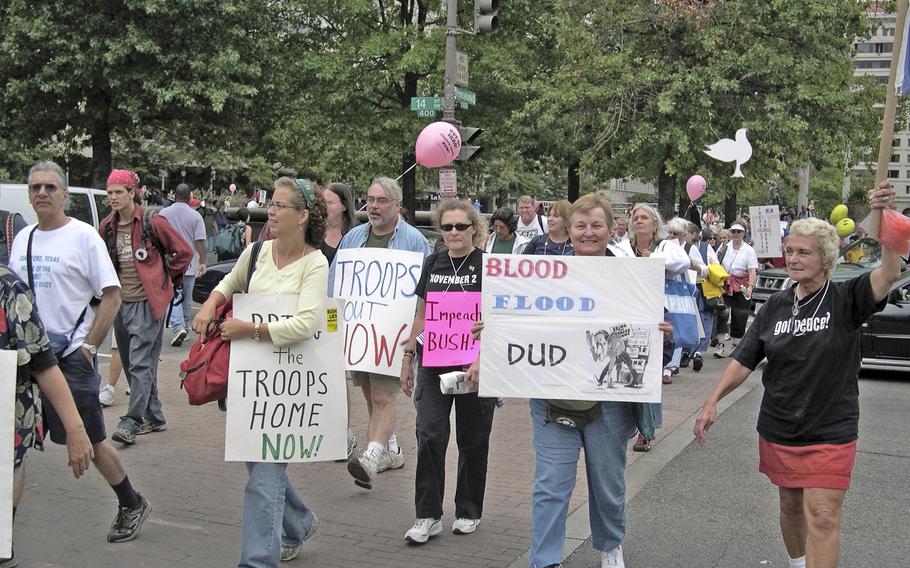
Anti-war demonstrators walk down Pennsylvania Avenue in Washington on their way to the National Mall to gather for a march past the White House. (Patrick Dickson/Stars and Stripes)
This article first appeared in the Stars and Stripes Mideast edition, Sept. 25, 2005. It is republished unedited in its original form.
WASHINGTON — They came by bus from California. And Illinois. And New Mexico. And New York.
Their message was simple. End the Iraq war. And Haiti interventionism. And torture. And the John Roberts nomination. And bigotry.
Though the message drifted, the protesters were there in number.
They poured off buses around the National Mall to gather and march, voicing opposition to Bush administration policies in Iraq and to work to bring the troops home. Organizers had predicted 100,000; the D.C. police chief was quoted as saying “they probably hit that.” By midafternoon they were estimating that 250,000 people had showed up.
The protesters exchanged high-fives as they got off the buses, trying to form a game plan, asking directions, and reveling in the concert-like atmosphere of a growing crowd.
There were even soldiers in uniform.
A specialist from the 101st Airborne who asked not to be identified talked about his friends in Iraq, and questioned the reasons given for invading.
“In my opinion, it’s just [expletive.] This [President] Bush went in there because of his dad, to settle a score. There’s no [weapons of mass destruction].
“But now we’re stuck in there. It’s not gonna be over for years. If we pull out, it’s gonna be worse.”
A sergeant with the 42nd Infantry Division nodded agreement.
Melanie Morgan, founder of Move America Forward, an organization “committed to supporting America’s efforts to defeat terrorism and supporting the brave men and women of our Armed Forces,” had a different take.
She was speaking at a small counter-demonstration near the Mall.
“Those ’60s hippies over at the Mall don’t understand,” Morgan shouted to about 200 people.
A compatriot, Bill Green, then took the stage.
“It’s more difficult to get us together, because we have lives! And jobs!” he shouted. “But the silent majority will be silent no more. You want to bring the troops home? Complete the mission, and bring the troops home.”
But the day belonged to the anti-war crowd, it seemed.
The protesters were preparing to march on a route that would pass the White House and return to the Mall for an afternoon concert. Protests against the IMF and World Bank were also planned.
Jamie Santoro, a 40-year-old editor with a book company in Chicago, rode 18 hours with 40 friends to participate.
“I came because I think war is wrong in every circumstance,” she said. What about in fighting someone such as Hitler? “War is always wrong.”
Arianette Gosnell, 18, a student at Lorain County Community College in Ohio, drove out with her friends.
She was handing out flyers that read “RESIST OR DIE! NO SCHOOL ON NOV. 2!”
Asked what the group hoped to accomplish by not going to class for a day, she said, “Actually, I just got involved today, so I don’t know.”
Ali Siam, 21, a mechanical engineering student “with a political science hobby” at Northeastern University in Boston, came down by bus with 15 to 20 fellow students, all of Middle Eastern descent.
He had a bit better of an idea why he was there.
“Every war is about economics,” Siam said. He said the the Bush administration went in to Iraq to secure oil supplies.
“It’s such a whitewash, this whole comic-book version of good vs. evil. Anybody who thinks this war is about spreading democracy is naive.”